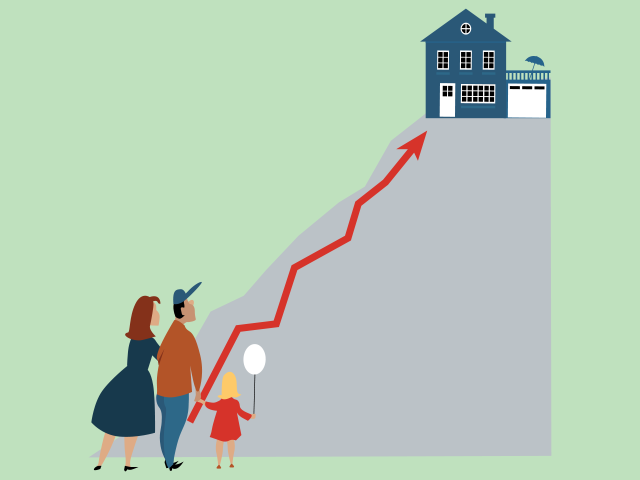The Fifty-Year Mortgage Mirage
The proposal for government-backed fifty-year mortgages arrives with earnest purpose and impeccable timing. Few doubt the need for relief: housing affordability has reached crisis levels. Americans buying homes today typically devote nearly 40 percent of their income to mortgage payments, and the average first-time buyer is 40 years old, an age that once marked the midpoint of a homeowner’s journey, not its hesitant beginning.
Federal Housing Finance Agency Director Bill Pulte has called the idea a “complete game changer,” and one understands the hope behind the phrase. Extending a $400,000 loan from 30 to 50 years at five percent interest trims monthly payments by roughly $330—a fifteen percent reduction that could turn a mortgage rejection into an approval. For many families, that arithmetic carries the promise of a front door, a backyard, and the first foothold on the American dream.
Yet in finance, as in physics, every gain carries its equal and opposite burden. The very mechanics that make ultra-long mortgages appealing to borrowers make them difficult to sustain for lenders and investors. The political aspiration for affordability runs headlong into the arithmetic of risk and time.
(iStock/Getty Images)
The Longevity Argument
There is an intuitive appeal to lengthening mortgage obligations based on the extension of American life expectancies. When the 30-year mortgage became standard in the mid-twentieth century, life expectancy hovered around 60. Today it approaches 80. If Americans live and work longer, why not borrow longer as well?
While there is truth in that comparison, it conceals as much as it reveals. The extra years we’ve gained by necessity are clustered near the end of life, when health and earning power are waning. No one has figured out how to give us a few more years of youth. Retirement incomes remain modest: roughly two-thirds of older Americans rely chiefly on Social Security, and a third depend on it almost entirely. Asking retirees to service mortgage payments on fixed incomes risks turning longevity from blessing to burden.
The data counsel caution. The share of homeowners aged 65 and older who still carry mortgages has risen from 25 percent in 1998 to 37 percent by 2019, and these borrowers experience the highest foreclosure rates of any age group. The traditional goal of a mortgage-free retirement endures for sound reasons. Longer lives do not necessarily argue for longer loans; they merely give us more years in which to feel the consequences of them.
When Duration Meets Reality
Bond markets have spent centuries learning a simple truth: time is risk. The longer a loan endures, the more it exposes its holder to the unpredictable tempests of interest rates and inflation. Mortgage investors live with a particularly vexing twist known as prepayment risk, the tendency for borrowers to refinance when rates fall and to stay put when rates rise. Investors wind up holding the mortgage longest when they least want to keep it—when rates have risen and better returns beckon elsewhere—and lose it precisely when they most want to hold on, as rates fall and the fixed yield looks increasingly attractive. It’s like being thrown out of the party just when the good wine is being served.
A 50-year mortgage magnifies this dilemma enormously. Lenders and investors must contemplate an obligation that could persist for half a lifetime, through multiple economic cycles and countless shifts in policy. The uncertainty alone commands a price.
Markets express that cost in the form of interest-rate spreads. Today, 30-year mortgages typically carry rates about 60 basis points higher than 15-year loans, a modest premium for the added risk of time. Even that is only possible because so many 30-year mortgages are subsidized by the government’s mortgage enterprises, Fannie Mae and Freddie Mac. By similar logic, a 50-year mortgage would likely require an additional half to three-quarters of a percentage point—or even more if they were made without government subsidies. What looks like a small difference on paper can quietly undo the supposed benefit of the longer term.
At seven percent instead of six and a quarter, that same $400,000 mortgage would cost roughly $2,407 per month, hardly less than the $2,463 owed on a 30-year loan. The lifetime picture is starker still: total interest payments swell from about $547,000 to over $1 million. The borrower trades a short-term comfort for a long-term encumbrance.
The 50-year mortgage, then, offers not so much affordability as illusion: an arithmetic kindness that conceals a financial burden spread across decades.
The Equity Trap
Even more consequential than the higher interest burden is the languid pace at which equity accumulates. After 10 years of payments, a homeowner with a 50-year mortgage has reduced the principal by barely 10 percent. Under a traditional 30-year loan, the same borrower would have retired nearly a quarter of the debt. This is not merely slower wealth-building; it is a different financial species altogether.
Most Americans do not inhabit their homes for half a century. The typical tenure runs between 8 and 13 years—long enough to raise a child or change careers, but far short of the horizon over which a 50-year mortgage rewards patience. A family that sells after a decade will have built little equity through amortization, depending almost entirely on price appreciation for any return. They have, in effect, rented from their bank while assuming every risk of ownership—property taxes, maintenance, and market volatility—without enjoying the traditional reward of forced savings.
This structure proves most fragile when the housing tide recedes. A modest price decline of even five to 10 percent could erase years of accumulated equity, leaving borrowers underwater and vulnerable to default. The very feature that makes the long mortgage alluring in calm conditions—the minimal monthly payment—becomes perilous in stress, for it leaves no cushion against loss.
The 50-year mortgage thus risks converting a generation of would-be homeowners into highly leveraged tenants of their own dreams—a generation of owners in name but renters in substance.

(iStock/Getty Images)
The Price Capitalization Problem
Suppose, for the sake of argument, that the machinery of policy and finance aligns: that regulators permit the innovation, that Fannie Mae and Freddie Mac stand ready to insure it, and that investors agree to hold these elongated mortgages at rates the public can afford. What then?
Basic economics offers a disquieting answer. In markets where housing supply is fixed or slow to expand—which is to say, in nearly every desirable city—policies that enlarge borrowing capacity tend to raise prices rather than expand access. When buyers can suddenly afford homes priced 10 or 15 percent higher, sellers respond in kind. The extra purchasing power is swiftly capitalized into property values.
The beneficiaries of such a shift are existing homeowners, whose assets appreciate, not the aspiring families whom the policy is meant to help. Those new buyers do gain entry—but at inflated prices and with heavier debts. The immediate relief of a smaller monthly payment masks a future burden of larger total costs.
There is also a political calculus worth noting. Policymakers who champion 50-year mortgages may earn applause today for expanding access to homeownership. But 15 or 20 years hence, when borrowers tally their payments and discover they have paid twice the purchase price of their home while barely denting the principal, gratitude may curdle into resentment. The politician who delivered the key will be long gone while the homeowner will still be writing checks. Such delayed consequences are easy to discount in the urgency of a crisis, but they have a way of arriving nonetheless.
We’ve seen this reaction in outrage over student loans. Many borrowers are later shocked to find that the loans they agreed to in their late teens and early twenties are still major liabilities into their thirties and forties. Although they may have understood the idea that a borrower always pays more than the principal of the loan, they frequently underestimated just how much interest they would owe and how much more they would eventually be required to repay.
This pattern is not conjecture but history. The mortgage interest deduction, long promoted as a spur to homeownership, has been shown repeatedly to bid up prices rather than increase ownership rates. The same logic would apply here: unless supply expands, the market will absorb the benefit of cheaper credit and deliver higher prices in return.
In that sense, the 50-year mortgage risks treating the symptom of sticker shock while aggravating the disease: the chronic undersupply of homes.
International Precedents Offer Little Comfort
Experience abroad offers more warning than encouragement. Japan’s Flat 50 program exists only under careful constraint: borrowers must repay by age 80, effectively limiting participation to those young enough to finish before retirement. Even then, uptake has been modest and largely confined to the country’s priciest metropolitan areas.
The United Kingdom has experimented on a smaller scale, allowing 50-year terms for select covered bonds. Yet these remain niche instruments—financial curiosities rather than mainstream products. Spain’s brief venture into ultra-long mortgages during the mid-2000s housing boom ended abruptly when the market collapsed, leaving banks with heavy losses and households with ruinous debt.
The lesson from these experiments is not that such loans are impossible, but that they require narrow tailoring and constant supervision. They can function as specialized tools for specific circumstances—perhaps for younger borrowers in high-cost regions—but they struggle to thrive as a national standard. The risks grow faster than the benefits.
Governments may bear those risks for a time, but history suggests that even generous backing cannot indefinitely outwit financial gravity.
A Policy That Circles the Block
The 50-year mortgage proposal springs from a sincere desire to widen the path to ownership. It is an imaginative response to an undeniable problem: homes cost too much for too many. Yet its ingenuity lies more in financial engineering than in economic remedy.
Housing is unaffordable because supply is constrained, not because the calendar is too short. Extending repayment schedules cannot conjure new homes. It can only rearrange who bears the burden and when. Stretching debt across half a century may ease the monthly strain, but it also stretches risk across generations, across market cycles, and across taxpayers who may one day underwrite the losses.
If adopted, the 50-year mortgage would likely remain a boutique instrument: helpful in a few special cases, but far from the transformative reform its advocates envision. Without substantial subsidy, the rate premium will erode the benefit. With subsidy, the effect will likely appear in higher home prices rather than greater affordability.
The administration’s impulse deserves respect. It confronts a genuine crisis with creativity and good faith. But the soundest course is not to extend the horizon of debt. It is to widen the foundation of opportunity by building more single-family homes where people wish to live. Until that happens, the 50-year mortgage offers not a new beginning, but a graceful detour around the same old constraint.

















